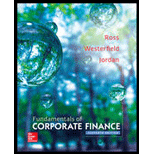
To determine: The standard deviation of the stock.
Introduction:
Expected return refers to the return that the investors expect on a risky investment in the future.
Standard deviation refers to the variation in the actual returns from the expected returns.
Answer to Problem 13.1CTF
The standard deviation of the stock is 3.82 percent.
Explanation of Solution
Given information:
A stock’s return is 15 percent when the economy is in a boom and 7 percent when the economy is normal. The probability of having a booming economy is 35 percent, and the probability of having a normal economy is 65 percent.
The formula to calculate the expected return on the stock:
The formula to calculate the standard deviation of the stock:
Compute the expected return:
“R1” is the returns in a booming economy. The probability of having a booming economy is “P1”. Similarly, “R2” is the returns in a normal economy. The probability of having a normal economy is “P2”.
Hence, the expected return on the stock is 9.8 percent.
Compute the standard deviation:
“R1” is the returns in a booming economy. The probability of having a booming economy is “P1”. Similarly, “R2” is the returns in a normal economy. The probability of having a normal economy is “P2”.
Hence, the standard deviation of the stock is 3.82 percent.
Want to see more full solutions like this?
Chapter 13 Solutions
Fundamentals of Corporate Finance
 Essentials Of InvestmentsFinanceISBN:9781260013924Author:Bodie, Zvi, Kane, Alex, MARCUS, Alan J.Publisher:Mcgraw-hill Education,
Essentials Of InvestmentsFinanceISBN:9781260013924Author:Bodie, Zvi, Kane, Alex, MARCUS, Alan J.Publisher:Mcgraw-hill Education,

 Foundations Of FinanceFinanceISBN:9780134897264Author:KEOWN, Arthur J., Martin, John D., PETTY, J. WilliamPublisher:Pearson,
Foundations Of FinanceFinanceISBN:9780134897264Author:KEOWN, Arthur J., Martin, John D., PETTY, J. WilliamPublisher:Pearson, Fundamentals of Financial Management (MindTap Cou...FinanceISBN:9781337395250Author:Eugene F. Brigham, Joel F. HoustonPublisher:Cengage Learning
Fundamentals of Financial Management (MindTap Cou...FinanceISBN:9781337395250Author:Eugene F. Brigham, Joel F. HoustonPublisher:Cengage Learning Corporate Finance (The Mcgraw-hill/Irwin Series i...FinanceISBN:9780077861759Author:Stephen A. Ross Franco Modigliani Professor of Financial Economics Professor, Randolph W Westerfield Robert R. Dockson Deans Chair in Bus. Admin., Jeffrey Jaffe, Bradford D Jordan ProfessorPublisher:McGraw-Hill Education
Corporate Finance (The Mcgraw-hill/Irwin Series i...FinanceISBN:9780077861759Author:Stephen A. Ross Franco Modigliani Professor of Financial Economics Professor, Randolph W Westerfield Robert R. Dockson Deans Chair in Bus. Admin., Jeffrey Jaffe, Bradford D Jordan ProfessorPublisher:McGraw-Hill Education





